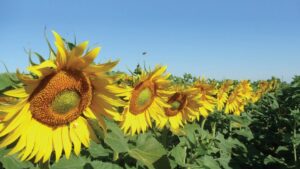Funding is critical in every sector. For the seed industry, changes in both the amount of government funding into crop genetics and specific areas of funding focus can have many industry impacts.
Canada’s funding landscape
At the federal level, the Canadian government invests in seed/crop genetics research through multiple funding mechanisms, including the federal ministry of agriculture (Agriculture and Agri-Food Canada, AAFC), the National Research Council, and Innovation, Science and Economic Development Canada. As in other countries, some of this money goes to government scientists and to university researchers.
“The funding covers the full range of the science innovation continuum, from foundational science through to the development of finished varieties, and a wide range of crop types,” states an AAFC spokesperson. However, “given the multiple sources and recipients of federal government funding in this broad research area, an overall investment figure is not available.”
Specific projects in Canada
In March,Agriculture and Agri-Food Canada announced an investment of up to $750,000 for SeedChange to support increase commercial adoption and use of Canadian-grown grain and vegetable seed, enhance the practice of farmer-led plant breeding methodologies and increase market trade opportunities in the value chain. The project involves demonstration sites across the country to evaluate and showcase farmer-bred and/or Canadian-grown varieties.
SeedChange is a Canadian organization that delivers tailored projects that help Canadians and other farmers around the world (about $35,000 in total). For three decades, they have assisted saving, sharing and breeding new seeds, restore degraded lands and soil through regenerative techniques and much more.
Another major Canadian funding initiative that supports crop genetics research is the AgriScience program which in turn funds the Diverse Field Crop Cluster (DFCC). Under this initiative, new camelina cultivars are being created. This crop has been grown on the Canadian Prairies since 2008. AAFC scientists are working with Smart Earth Camelina Corporation in this work.
DFCC funding also supports the Northern Quinoa Production Corporation to develop four ‘made for Canada’ quinoa varieties by 2023. DFCC is also supporting a flax variety development initiative at the University of Saskatchewan’s Crop Development Centre. Three new varieties (two brown and one yellow coloured seed) will be released next year.
A special breeding project
AAFC notes that Canadian crop breeders have made significant progress, with the identification and development of wheat varieties with resistance to fusarium head blight and wheat midge.
However, if those in the Canadian agriculture and seed industries were asked Canada’s biggest accomplishment in crop breeding, the vast majority would point to canola, the only crop ‘made in Canada.’
Since its debut about two decades ago, canola has become one of the world’s most important oilseed crops. Its oil is used in many food products and its meal is used in feed for many types of livestock, including dairy cows, poultry, and fish, in North America and Asia. Its meal is also being actively examined for the plant-based food market.
The canola grown in Canada belongs to the Brassica napus, B. rapa or B. juncea species, which all belong to a much larger mustard family (Brassicaceae). It’s been derived from rapeseed, which was first cultivated in India over 4000 years ago. Rapeseed was grown as a cattle feed; its mid-to-high levels of erucic acid can be digested by cattle but not by humans. In Canada during World War II, rapeseed was also grown (with seed imported from Argentina via the U.S.) to make lubricant oil for engines in Allied naval ships.
Starting in the 1970s, scientists at AAFC, the Saskatoon Research Centre and an organization called the Saskatchewan Wheat Pool (SWP) worked to breed a similar plant for human consumption, one with much lower levels of erucic acid. It took time, but success was eventually achieved. The new cultivar was named canola, (short for CANadian Oil Low Acid). In 2002, SWP introduced the first two cultivars to market, ‘Arid’ and ‘Amulet.’
Indeed, canola has a very healthy oil profile and breeding work continues to further improve it, and expand the selection of cultivars with various oil profiles.
According to Oklahoma State University, today’s commodity canola oil contains only traces of erucic acid, 5 to 8 per cent saturated fatty acids, 60 to 65 per cent monounsaturated fatty acids and 30 to 35 polyunsaturated fatty acids. However, breeders have developed cultivars with oils that are low linolenic (about 2 per cent), high oleic (60 to 85 per cent), high lauric (39 per cent), high stearic (40 per cent), high palmitic (10 per cent) and high in gamma linolenic acid. These oil types are suited to frying, confectionary, coatings, coffee whiteners, whipped toppings, and to produce trans fats-free foods such as bread and bakery products.
There is also canola breeding in Canada and beyond to improve tolerance to drought, excess moisture and late spring and/or early fall frosts, elimination of green seed, improved nutrient use efficiency and disease resistance (clubroot, blackleg, sclerotinia, verticillium stripe, etc.). Breeders are also working to build better insect resistance (flea beetle, root maggot, cabbage seedpod weevil, etc.), reduced pod shatter and pod drop, cold temperature seedling tolerance and of course, higher yields.
On that note, among the many current canola breeding projects supported by the Canola Council of Canada and government funding includes work atUniversity of Guelph in Ontario focusing on corn genes. Previous research has shown that corn genes inserted into Arabidopsis plants produced a 250 per cent increase in total seed oil produced per plant. This research team is investigating whether these same corn genes will have a similar effect in B. napus.
Another project taking place across several Canadian institutions involves screening several populations for diversity of protein quality and digestibility and mapping the genes responsible. Yet another multi-institution project involves characterizing nitrogen metabolism factors in a diverse collection of B. napus. Data generated through these experiments will be used to test potential screening methodology and identify traits related to rhizosphere ‘nitrogen-cycling.’
For information on seed research in the United States, read part one of this article here.
Contacts for publication records
NIFA NIFAMediaRequests@usda.gov John Martins Senior Public Affairs Specialist
USDA, National Institute of Food and Agriculture (401) 230-7910 | nifa.usda.gov
ASTA – Bethany Shively Vice President, Strategic Communications American Seed Trade Association bshively@betterseed.org; info@betterseed.org (703) 837-8140
Seeds Canada 613-236-6451 info@seeds-canada.ca, did not respond
Canadian Seed Growers Association (613) 236-0497 info@seedgrowers.ca Tania Calverley comms X 229, declined to comment but sent links
Agriculture and Agri-food Canada Media Relations aafc.mediarelations-relationsmedias.aac@agr.gc.ca
Read More from the November Issue:













